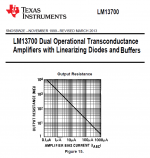In honour of the true. Which are they, How can I recognize one of them.
I coming watching with all my mind and trying to think how they work and which is the clue part in the circuit. I read the most articles I could not got but at the moment is no objective for my mind. The F1 the F2, the CSX, the A75. Please if anybody in this honourable forum, maybe there are somebody like me. Some body said that high sensitive fullrange horns are the perfect weeding for they. I have one since long time and now I am a little tired with it. I read the article "Current Source Amplifiers and sensitive full range drivers" And others from Joe Rasmusen. But I can't recognize.
Thanks in advance
I coming watching with all my mind and trying to think how they work and which is the clue part in the circuit. I read the most articles I could not got but at the moment is no objective for my mind. The F1 the F2, the CSX, the A75. Please if anybody in this honourable forum, maybe there are somebody like me. Some body said that high sensitive fullrange horns are the perfect weeding for they. I have one since long time and now I am a little tired with it. I read the article "Current Source Amplifiers and sensitive full range drivers" And others from Joe Rasmusen. But I can't recognize.
Thanks in advance
Last edited:
Pragmatically speaking you can use open loop output impedance as an indicator. If output impedance Zout exceeds (10 * Vsupply / Isupply_max) then the amplifier being studied is probably a transconductance amplifier.
Let's work an example. The Texas Instruments LM13700 IC is, unambiguously and indisputably, a transconductance amplifier. See below. According to the datasheet its Vsupply is 36V and its Isupply_max is 20mA. Thus our pragmatic indicator would say "yes it is a transconductance amplifier" if and only if
Other members may have their own preferred value of the coefficient in the inequality; they may wish to replace "10" by a different number.
_
Let's work an example. The Texas Instruments LM13700 IC is, unambiguously and indisputably, a transconductance amplifier. See below. According to the datasheet its Vsupply is 36V and its Isupply_max is 20mA. Thus our pragmatic indicator would say "yes it is a transconductance amplifier" if and only if
- Zout > (10 * 36 / 0.02) ... ... ... numerically, Zout > 18 kohms
Other members may have their own preferred value of the coefficient in the inequality; they may wish to replace "10" by a different number.
_
Attachments
Voltage source amplifier => low output impedance relative to speaker.
Current source amplifier => high output impedance relative to speaker.
Also, it is a good idea to avoid using current source amps within ~ 2 octaves of driver fs. They really shine on multi way speakers though.
( I have Zen-ish current source amps with ~ 700 output impedance for my mid / tweets )
Current source amplifier => high output impedance relative to speaker.
Also, it is a good idea to avoid using current source amps within ~ 2 octaves of driver fs. They really shine on multi way speakers though.
( I have Zen-ish current source amps with ~ 700 output impedance for my mid / tweets )
Also, it is a good idea to avoid using current source amps within ~ 2 octaves of driver fs
This depends on the Qms and the enclosure the driver is in.
My BIBs with B&C 10PS26 work very good with +500 ohm output impedance.
The very wide band hornloading starting a full octave below fs, and keeps the cone well controlled at Fs even though a Qms of the driver of 2,9.
regards,
Johannes
Hi, thanks gentlemen, BTW that is true, operational transconductance amplifier and the idea of voltage/current-source amplifier with the correlative low and high impedance over the speaker.
Thanks a lot but I wanna recognize a topology that show us. People say that F2J, the only I can distinguish over other is the parallel of resistors with the load. But essentially how they work?
The paradigm of damping, load and bandwidth in amplifiers is clear, I guess until now. Somebody, talked about high impedance over the speaker. That give an unbalance between the out with the load. I knew that triode amps became more linear with higher impedance of load.
Best Regards
- Status
- This old topic is closed. If you want to reopen this topic, contact a moderator using the "Report Post" button.
